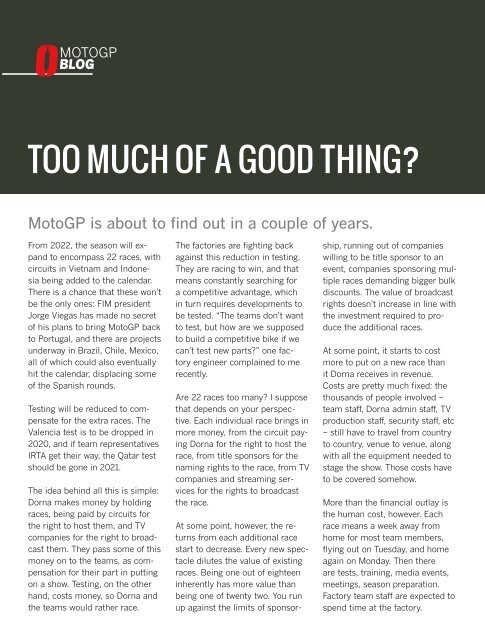You also want an ePaper? Increase the reach of your titles
YUMPU automatically turns print PDFs into web optimized ePapers that Google loves.
MOTOGP<br />
BLOG<br />
TOO MUCH OF A GOOD THING?<br />
MotoGP is about to find out in a couple of years.<br />
From 2022, the season will expand<br />
to encompass 22 races, with<br />
circuits in Vietnam and Indonesia<br />
being added to the calendar.<br />
There is a chance that these won’t<br />
be the only ones: FIM president<br />
Jorge Viegas has made no secret<br />
of his plans to bring MotoGP back<br />
to Portugal, and there are projects<br />
underway in Brazil, Chile, Mexico,<br />
all of which could also eventually<br />
hit the calendar, displacing some<br />
of the Spanish rounds.<br />
Testing will be reduced to compensate<br />
for the extra races. The<br />
Valencia test is to be dropped in<br />
2020, and if team representatives<br />
IRTA get their way, the Qatar test<br />
should be gone in 2021.<br />
The idea behind all this is simple:<br />
Dorna makes money by holding<br />
races, being paid by circuits for<br />
the right to host them, and TV<br />
companies for the right to broadcast<br />
them. They pass some of this<br />
money on to the teams, as compensation<br />
for their part in putting<br />
on a show. Testing, on the other<br />
hand, costs money, so Dorna and<br />
the teams would rather race.<br />
The factories are fighting back<br />
against this reduction in testing.<br />
They are racing to win, and that<br />
means constantly searching for<br />
a competitive advantage, which<br />
in turn requires developments to<br />
be tested. “The teams don’t want<br />
to test, but how are we supposed<br />
to build a competitive bike if we<br />
can’t test new parts?” one factory<br />
engineer complained to me<br />
recently.<br />
Are 22 races too many? I suppose<br />
that depends on your perspective.<br />
Each individual race brings in<br />
more money, from the circuit paying<br />
Dorna for the right to host the<br />
race, from title sponsors for the<br />
naming rights to the race, from TV<br />
companies and streaming services<br />
for the rights to broadcast<br />
the race.<br />
At some point, however, the returns<br />
from each additional race<br />
start to decrease. Every new spectacle<br />
dilutes the value of existing<br />
races. Being one out of eighteen<br />
inherently has more value than<br />
being one of twenty two. You run<br />
up against the limits of sponsorship,<br />
running out of companies<br />
willing to be title sponsor to an<br />
event, companies sponsoring multiple<br />
races demanding bigger bulk<br />
discounts. The value of broadcast<br />
rights doesn’t increase in line with<br />
the investment required to produce<br />
the additional races.<br />
At some point, it starts to cost<br />
more to put on a new race than<br />
it Dorna receives in revenue.<br />
Costs are pretty much fixed: the<br />
thousands of people involved –<br />
team staff, Dorna admin staff, TV<br />
production staff, security staff, etc<br />
– still have to travel from country<br />
to country, venue to venue, along<br />
with all the equipment needed to<br />
stage the show. Those costs have<br />
to be covered somehow.<br />
More than the financial outlay is<br />
the human cost, however. Each<br />
race means a week away from<br />
home for most team members,<br />
flying out on Tuesday, and home<br />
again on Monday. Then there<br />
are tests, training, media events,<br />
meetings, season preparation.<br />
Factory team staff are expected to<br />
spend time at the factory.

















